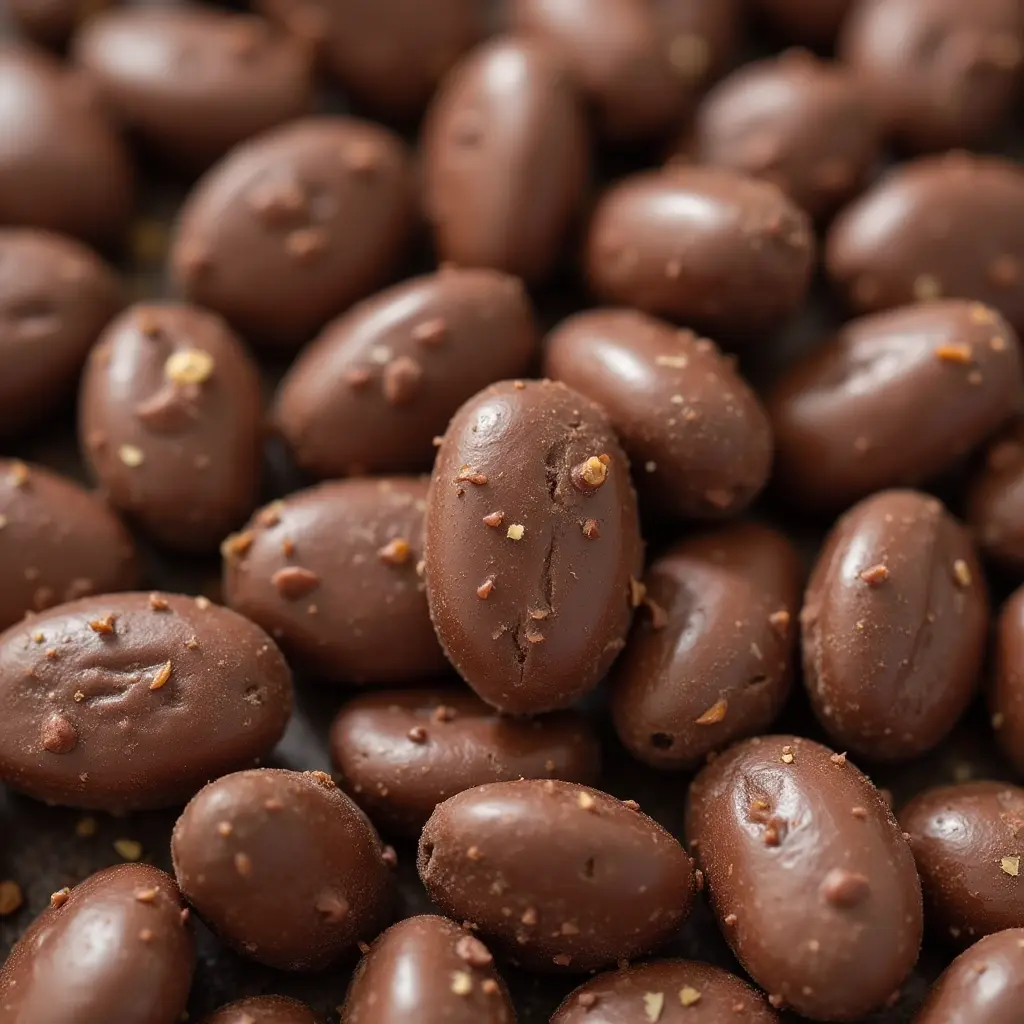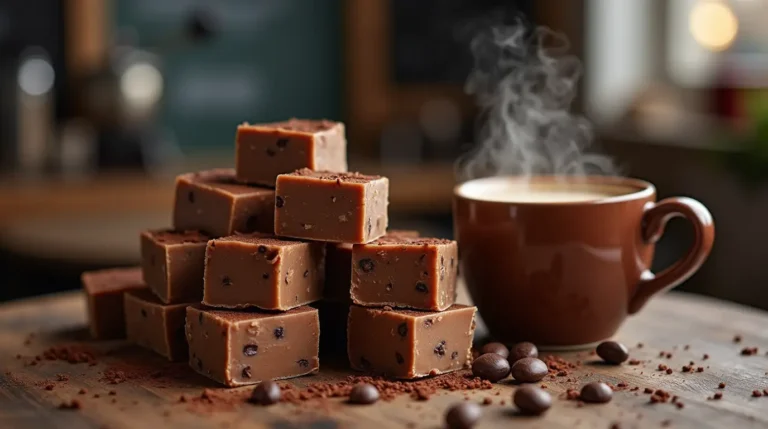How Much Caffeine is in Chocolate Covered Espresso Beans? 5 Amazing Benefits!
The Perfect Pick-Me-Up or Just Too Much?
Picture this: it’s mid-afternoon, and you feel your energy fading. You’re reaching for something to give you that needed boost without committing to a full cup of coffee. Suddenly, there they are—those delightful chocolate covered espresso beans, perfect for a quick, delicious burst of caffeine. They look harmless, easy to pop in, and so deliciously sweet with that hit of espresso underneath. But, as with any caffeine-packed snack, the question remains: just how much caffeine is in chocolate covered espresso beans?
Let’s break down everything you need to know about the caffeine content in these tasty bites, why they’re so popular, and how many you can safely enjoy.
Table of Contents
What Are Chocolate Covered Espresso Beans?
Chocolate-covered espresso beans combine the best of both worlds: the deep, bold flavor of coffee with the smooth sweetness of chocolate. They’re made simply by coating whole roasted espresso beans with chocolate, often milk or dark chocolate. These beans have become popular not only for their taste but also because they offer a quick and portable caffeine fix.
When you pop one in your mouth, you’re getting the natural caffeine content of the espresso bean plus a little extra from the chocolate coating. But this also means that even a handful of these beans can deliver more caffeine than you might realize.

How Much Caffeine is in a Single Chocolate Covered Espresso Bean?
One of the most common questions people have is, “How much caffeine is in a single chocolate-covered espresso bean?” Let’s get to the details:
Each chocolate-covered espresso bean has an average of 7-10 mg of caffeine. However, the actual amount can vary depending on a few key factors:
- Bean Size: Larger beans may contain slightly more caffeine than smaller ones.
- Chocolate Type: Dark chocolate tends to have slightly more caffeine than milk chocolate.
- Roasting Level: Espresso beans typically go through a dark roast, which reduces their caffeine content slightly compared to lighter roasts.
Caffeine Breakdown Table
| Bean Type | Chocolate Type | Average Caffeine per Bean (mg) |
|---|---|---|
| Espresso Bean | Milk Chocolate | 7 mg |
| Espresso Bean | Dark Chocolate | 10 mg |
| Decaf Espresso Bean | Milk or Dark Chocolate | Less than 1 mg |
The caffeine from the chocolate is generally minor compared to the espresso bean, but when you’re snacking on a few, these amounts can quickly add up.
How Much Caffeine is in a Serving of Chocolate Covered Espresso Beans?
A common serving size for chocolate-covered espresso beans is about 10–15 beans, which could deliver anywhere from 70–150 mg of caffeine, depending on the type of chocolate and bean size.
Let’s look at a breakdown of different serving sizes for a clearer idea:
- Light Snack (5 beans): Around 35–50 mg of caffeine
- Standard Serving (10 beans): Roughly 70–100 mg of caffeine
- Hearty Serving (15 beans): Approximately 105–150 mg of caffeine
Eating just a handful can give you almost as much caffeine as a full cup of coffee, which usually has about 95 mg of caffeine. So, while it may feel like you’re only having a light snack, chocolate-covered espresso beans can pack a caffeine punch.


Serving Size vs. Caffeine Table
| Serving Size (beans) | Approximate Caffeine Content (mg) |
|---|---|
| 5 | 35–50 |
| 10 | 70–100 |
| 15 | 105–150 |
Benefits of Chocolate Covered Espresso Beans as a Caffeine Source
Chocolate-covered espresso beans aren’t just tasty; they come with a few extra perks too:
- Quick Energy Boost: The combination of caffeine and sugar in these beans makes for a fast, easy energy boost. You’ll feel a lift in alertness within minutes.
- Antioxidants: Coffee and chocolate are both packed with antioxidants that can help combat free radicals in your body, contributing to overall health.
- Convenience: Unlike a cup of coffee, you can carry these beans anywhere for a portable and mess-free caffeine boost.
When you’re looking for a way to stay awake and alert on the go, chocolate-covered espresso beans are a convenient alternative to traditional coffee or energy drinks.
Health Considerations and Potential Risks of Eating Too Many
As with anything, moderation is key. Chocolate-covered espresso beans come with a few considerations:
Caffeine Sensitivity and Potential Side Effects
Caffeine affects everyone differently, and some people are more sensitive to its effects than others. Eating too many chocolate-covered espresso beans can lead to symptoms like:
- Jitters or Anxiety
- Increased Heart Rate
- Difficulty Sleeping
If you’re particularly sensitive to caffeine or have a low tolerance, even a small serving of these beans could cause noticeable side effects.
Sugar Content
Don’t forget the chocolate! Most chocolate-covered espresso beans are made with sweetened chocolate, which means they contain added sugars. Eating too many could add unwanted calories and sugar to your diet, so be mindful of how many you consume.
Recommended Daily Caffeine Intake
According to the FDA, the general recommendation is to consume no more than 400 mg of caffeine per day for most adults. Since a serving of 10–15 beans can reach up to 150 mg, keep this in mind if you’re also having other sources of caffeine throughout the day.


How Many Chocolate Covered Espresso Beans Are Safe to Eat?
Now that you know the caffeine content, let’s talk about safe consumption. Generally, around 10–15 beans are considered safe for most adults. However, if you have a high caffeine tolerance, you may be able to enjoy a few more without issues. Here’s a quick guide:
- Low Tolerance (sensitive to caffeine): 5–10 beans
- Moderate Tolerance: 10–15 beans
- High Tolerance: Up to 20 beans, if consumed mindfully
Pay attention to your body’s signals, and if you start to feel jittery or anxious, it’s probably a sign to ease up on the beans.
Popular Recipes Using Chocolate Covered Espresso Beans
Looking to elevate your caffeine treats? Try incorporating chocolate-covered espresso beans into delicious recipes for a gourmet twist!
Recipe 1: Chocolate Espresso Bean Cookies
| Ingredient | Quantity |
|---|---|
| Flour | 1 cup |
| Baking powder | 1 tsp |
| Butter | 1/2 cup |
| Brown sugar | 1/2 cup |
| Chocolate-covered beans | 1/2 cup, chopped |
Instructions:
- Preheat your oven to 350°F (175°C).
- Combine dry ingredients in a bowl.
- Mix in butter and sugar until smooth.
- Fold in chopped chocolate-covered espresso beans.
- Bake for 10–12 minutes until edges are golden.
Recipe 2: Mocha Ice Cream Topping
| Ingredient | Quantity |
|---|---|
| Chocolate-covered beans | 1/4 cup, crushed |
| Caramel sauce | 2 tbsp |
| Heavy cream | 2 tbsp |
Instructions:
- Warm caramel sauce and heavy cream in a saucepan.
- Stir in crushed beans.
- Drizzle over your favorite ice cream!
These recipes make great treats, adding a fun twist to your usual desserts.
FAQs About Caffeine in Chocolate Covered Espresso Beans
How many chocolate-covered espresso beans equal a cup of coffee?
On average, about 10–12 beans have the same amount of caffeine as an 8-ounce cup of coffee.
Is it safe to eat chocolate-covered espresso beans every day?
Yes, but moderation is key. Regular daily intake should be limited to avoid excessive caffeine and sugar consumption.
Are there any decaf chocolate-covered espresso beans?
Yes! Some brands offer decaf espresso beans, though they may still contain trace amounts of caffeine.
Does the type of chocolate impact caffeine levels?
Absolutely. Dark chocolate contains more caffeine than milk chocolate, which can increase the total caffeine in each bean.
Conclusion
Chocolate-covered espresso beans are a delicious, convenient snack that can give you a quick boost of energy. However, with their caffeine content, they’re best enjoyed in moderation. Whether you’re a fan of a quick handful on the go or looking to add them to your favorite recipes, knowing how much caffeine they contain helps you manage your intake.
Ready to enjoy chocolate-covered espresso beans responsibly? Try out one of the recipes above or savor them as-is. And remember, a little bit goes a long way!







